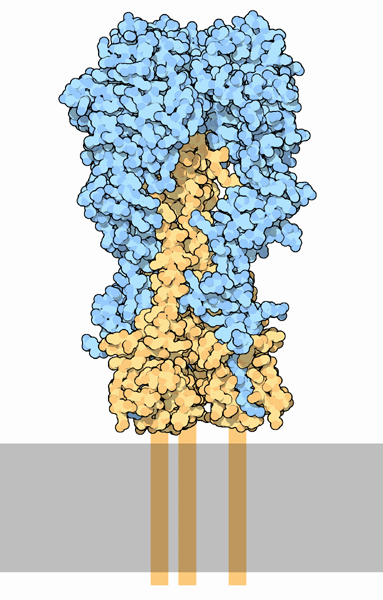|
Inhaltsübersicht | Nanomaschinen | Moleküle | Programme | Kurse | Fun | Links |
||
| > |
Hemagglutinin

Influenza virus is a dangerous enemy. Normally, the immune system fights off infections, eradicating the viruses and causing a few days of miserable flu symptoms. Yearly flu vaccines prime our immune system, making it ready to fight the most common strains of influenza virus. But once every couple of decades, a new strain of influenza appears that is far more pathogenic, allowing it to spread rapidly. This happened at the end of World War I, and the resultant pandemic killed over 20 million people, more than twice the number of people that were killed in the war.
Target and Attack
Hemagglutinin is one of the reasons that influenza virus is so effective. It is a spike-shaped protein that extends from the surface of the virus. In the active form, shown here from PDB entry 1ruz, hemagglutinin is composed of two different types of chains, shown in blue and orange. The blue chains are the targeting mechanism: they search for specific sugar chains on our cellular proteins. When they find the proper one, hemagglutinin binds to the cell and the orange chains initiate the attack, as shown on the next page. The name hemagglutinin refers to the ability of influenza to agglutinate red blood cells: the virus is covered with many hemagglutinin molecules, which together can glue many red blood cells together into a visible clump.
Stealthy Subtypes
The specificity, and thus the danger, of each strain of influenza virus depends on the particular type hemagglutinin that it carries. Over a dozen subtypes of hemagglutinin are known. Three of these (termed H1, H2, and H3) attack humans--they specialize in finding the particular sugars in our respiratory tract, so the infection occurs there when we get the flu. Other subtypes, such as H5, attack proteins in the digestive system of birds. Most of these are not dangerous to us, and do not typically threaten the lives of the birds, so they exist as an invisible reservoir of virus. A potential danger occurs when these different strains start trading genes.
The H5N1 avian influenza virus that is showing up in the news is decimating bird populations, but it is not currently a danger to us since it doesn't have the right hemagglutinin to attack human cells (the N1 designation refers to the subtype of a second virus protein: neuraminidase). However, there is the possibility that it could acquire a human-specific hemagglutinin, and then it could cause real problems. One way for this to happen involves pigs. Pigs are susceptible to viruses of several subtypes, both the types that attack birds and the types that attack us. If a single pig gets infected with two different viruses at the same time, the viruses can shuffle and trade genes during the infection. This could potentially be a way to construct a virus with the virulence of the bird virus, combined with the ability to attack human cells.
Deadly Agent
The hemagglutinin shown here is taken from an actual virus of the pandemic that killed so many people in 1918. The DNA encoding this hemagglutinin was isolated from preserved samples, and the hemagglutinin was made in the laboratory according to this genetic information. Two crystal structures were obtained, the active form shown here (PDB entry 1ruz), and a precursor form in PDB entry 1rd8. The protein is tethered to the virus membrane by a short segment of protein that is not seen in the crystal structure and is shown schematically here at the bottom.
Next: Hemagglutinin in Action
Last changed by: A.Honegger,